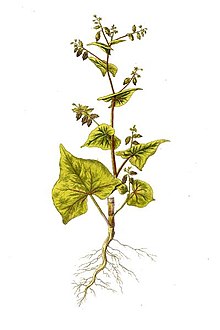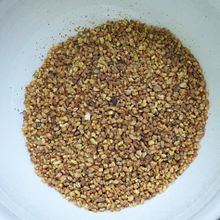Fagopyrum tataricum
This article needs additional citations for verification. (December 2009) |
| Tartar buckwheat | |
|---|---|

| |
| Scientific classification | |
| Kingdom: | |
| (unranked): | |
| (unranked): | |
| (unranked): | |
| Order: | |
| Family: | |
| Genus: | |
| Species: | F. tataricum
|
| Binomial name | |
| Fagopyrum tataricum | |
| Synonyms[1] | |
| |
Fagopyrum tataricum, also known as Tartary buckwheat,[2] duckwheat,[3] India buckwheat,[3] India wheat,[3] green buckwheat,[3] ku qiao,[3] or bitter buckwheat,[4] is a domesticated food plant in the genus Fagopyrum in the family Polygonaceae. With another species in the same genus, common buckwheat, it is often counted as a cereal, but unlike the true cereals the buckwheats are not members of the grass family. Thus they are not related to true wheat. Tartary buckwheat is bitterer, but contains more rutin than common buckwheat. It also contains quercitrin.[5]
Tartar buckwheat was domesticated in east Asia, and is also cultivated in Europe and North America.[6] While it is an unfamiliar food in the West, it is common in the Himalayan region today, as well as other regions in Southwest China such as Guizhou province.
The plant has been cultivated in many parts of the world though when found among other crops it is considered a weed.[7][8]

Ingredients
Fagopyrum tataricum contains aromatic substances. The most important difference from the aroma of Fagopyrum esculentum is the absence of salicylaldehyde and presence of naphthalene.[9]
References
- ^ "The Plant List: A Working Checklist of all Plant Species".
- ^ USDA, NRCS (n.d.). "Fagopyrum tataricum". The PLANTS Database (plants.usda.gov). Greensboro, North Carolina: National Plant Data Team. Retrieved 19 January 2016.
- ^ a b c d e "USDA GRIN Taxonomy".
- ^ Report of a Network Coordinating Group on Minor Crops. Bioversity International. pp. 65–66. GGKEY:J811QDJNL4H.
- ^ Tartary Buckwheat (Fagopyrum tataricum Gaertn.) as a Source of Dietary Rutin and Quercitrin. Nina Fabjan, Janko Rode, Iztok Jože Košir, Zhuanhua Wang, Zheng Zhang and Ivan Kreft, J. Agric. Food Chem., 2003, 51 (22), pp. 6452–6455, doi:10.1021/jf034543e
- ^ Li Anjen and Suk-pyo Hong (2004). "Fagopyrum tataricum". Flora of China. Vol. 5. Retrieved 16 December 2014.
- ^ "Interactive Agricultural Ecology Atlas of Russia and Neighbouring Countries". Retrieved 16 December 2014.
- ^ Sharma, M.P. (1986). "The Biology Of Canadian Weeds: 74. Fagopyrum tataricum (L.) Gaertn". Canadian Journal of Plant Science. 66 (2): 381–393. doi:10.4141/cjps86-052.
- ^ Janeš, D., Prosen, H., Kreft, S. (2012). Identification and Quantification of Aroma Compounds of Tartary Buckwheat (Fagopyrum tataricum Gaertn.) and Some of Its Milling Fractions. Journal of Food Science, Vol. 77, Nr. 7 http://onlinelibrary.wiley.com/doi/10.1111/j.1750-3841.2012.02778.x/abstract;jsessionid=7A2175971E011D4285D602B76601D37A.f03t03
External links
 Media related to Fagopyrum tataricum at Wikimedia Commons
Media related to Fagopyrum tataricum at Wikimedia Commons
